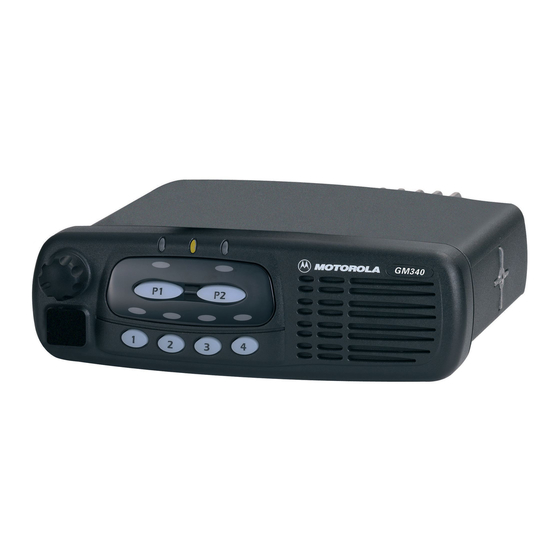Motorola GM660 Сервісна інформація - Сторінка 21
Переглянути онлайн або завантажити pdf Сервісна інформація для Радіо Motorola GM660. Motorola GM660 34 сторінки. Gm series professional radio uhf (403-470mhz)
Також для Motorola GM660: Сервісна інформація (32 сторінок), Сервісна інформація (32 сторінок)

VHF (136-174MHz) Transmitter Power Amplifier (PA) 45 W
5.6
Antenna Switch
The antenna switch consists of two PIN diodes, D3471 and D3472. In the receive mode, both diodes
are off. Signals applied at the antenna jack J3401 are routed, via the harmonic filter, through
network L3472, C3474 and C3475, to the receiver input. In the transmit mode, K9V1 turns on Q3471
which enables current sink Q3472, set to 96 mA by R3473 and VR3471. This completes a DC path
from PASUPVLTG, through L3473, D3471, L3477, L3472, D3472, L3471, R3474 and the current
sink, to ground. Both diodes are forward biased into conduction. The transmitter RF from the
directional coupler is routed via D3471 to the harmonic filter and antenna jack. D3472 also
conducts, shunting RF power and preventing it from reaching the receiver port (RXIN). L3472 is
selected to appear as a broadband lambda/4 wave transmission line, making the short circuit
presented by D3472 appear as an open circuit at the junction of D3472 and the receiver path.
5.7
Harmonic Filter
Components L3491-L3494 and C3489-C3498 form a nine-pole Chebychev low-pass filter to
attenuate harmonic energy of the transmitter to specifications level. R3490 is used to drain
electrostatic charge that might otherwise build up on the antenna. The harmonic filter also prevents
high level RF signals above the receiver passband from reaching the receiver circuits, improving
spurious response rejection.
5.8
Power Control
The transmitter uses the Power Control IC (PCIC, U3501) to control the power output of the radio. A
portion of the forward and reflected RF power from the transmitter is sampled by the directional
coupler, rectified and summed, to provide a DC voltage to the RFIN port of the PCIC (pin 1) which is
proportional to the sampled RF power.
The ASFIC contains a digital to analog converter (DAC) which provides a reference voltage of the
control loop to the PCIC via R3517. The reference voltage level is programmable through the SPI line
of the PCIC. This reference voltage is proportional to the desired power setting of the transmitter, and
is factory programmed at several points across the frequency range of the transmitter to offset
frequency response variations of the transmitter's power detector circuitry.
The PCIC provides a DC output voltage at pin 4 (INT) which is amplified and shifted in DC level by
stages Q3501 and Q3502. The 0 to 4 volt DC range at pin 4 of U3501 is translated to a 0 to 8.5 volt
DC range at the output of Q3501, and applied as VCONT to the power-adjust input pin of the first
transmitter stage U3401. This adjusts the transmitter power output to the intended value. Variations
in forward or reflected transmitter power cause the DC voltage at pin 1 to change, and the PCIC
adjusts the control voltage above or below its nominal value to raise or lower output power.
Capacitors C3502-4, in conjunction with resistors and integrators within the PCIC, control the
transmitter power-rise (key-up) and power-decay (de-key) characteristic to minimize splatter into
adjacent channels.
U3502 is a temperature-sensing device, which monitors the circuit board temperature in the vicinity
of the transmitter driver and final devices, and provides a dc voltage to the PCIC (TEMP, pin 29)
proportional to temperature. If the DC voltage produced exceeds the set threshold in the PCIC, the
transmitter output power will be reduced so as to reduce the transmitter temperature.
2-11
